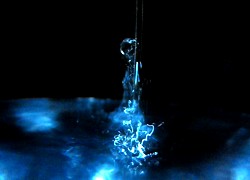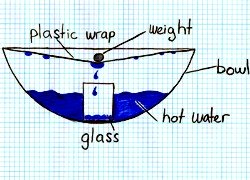Water Cycle Experiments
The Water Cycle For Kids
These two water cycle experiments will simulate the hydrologic cycle that occurs every day. Accumulation, evaporation, condensation and precipitation are all shown in this experiment. This experiment can help kids to understand the water cycle because they are able to observe it happening right up close. This experiment has great potential to be turned into a science fair project if the extension experiment was elaborated on. Instead of just trying it with salt other
substances can be mixed into the water. Then it can be observed whether they go through the water cycle with the water or whether they stay behind.
Our Top Gift Ideas for Young Scientists
 |
  |
 |
|---|
The water Cycle Experiment
The water cycle can be easily recreated in a truly easy experiment.
You will need:
- A big, see through bowl
- A small glass
- Cling film (thin plastic wrap)
- A small weight
- A cup of hot water
- A cup of ice shavings (optional)
Pour the hot water into the bowl then place the small glass in to the middle of the bowl. Cover the bowl with cling film and place the weight into the middle of the cling film above the glass. Place the ice shaving on to the cling film and spread it so it covers the top. Now you have finished setting it up you can watch the process (it can take a couple of minutes).
How it works
The hot water will start to evaporate and rise until it hits the cling film. It water will then condense causing small water droplets to form. If you used the ice shavings it will speed up the condensation process. The small water droplets then slowly run down to the indentation made by the weight. At this point more and more little water droplets gather until a big enough water droplet forms and it will drip down into the small glass simulating precipitation.
'Science Kids'
Stay updated and subscribe to "Science News For Kids" our monthly e-zine.
Extension Experiment
When water evaporates it leaves behind some impurities such as salts and metals. That’s why rain water does not taste salty even though a lot of the water comes from the oceans.
Instead of just putting the hot water into the bowl try putting in some salt and then you can compare the saltiness of the water in the bowl and the taste of the water in the small glass. The
easiest way to do this is by tasting it, but if you do decide to do so prepare the experiment as you would prepare food. Usually experiments should not be tasted, but when they are responsibly and knowingly prepared for ingestion then it is O.K.
Learn more about the water cycle.
Go back from the 'Water cycle experiments' to the home.

